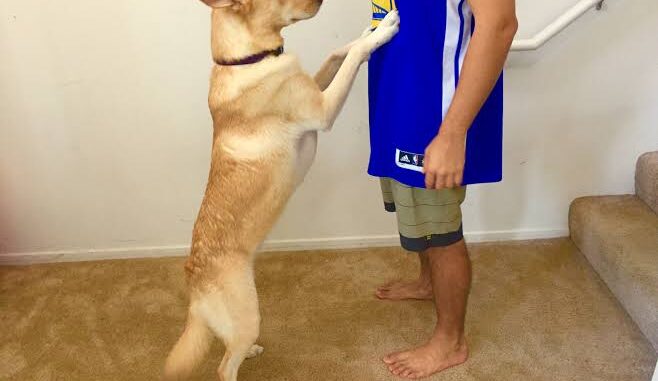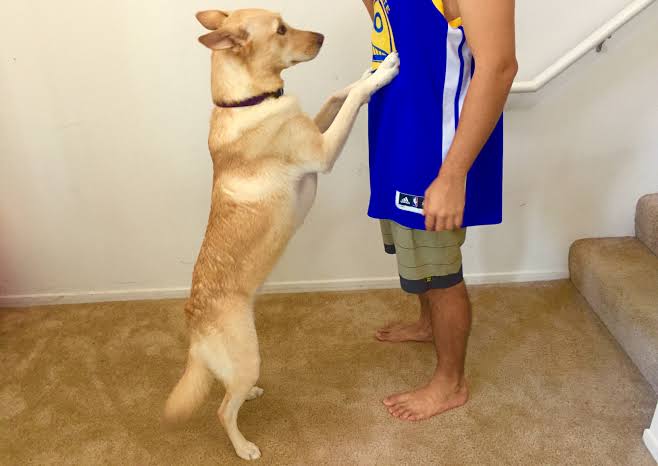
How to Stop Your Dog from Jumping on People: Dogs are naturally social creatures, and jumping is often their way of greeting people or seeking attention. While this behavior may seem harmless especially when your dog is small it can quickly become problematic.

Not only is it disruptive, but it can also be dangerous for children, the elderly, or anyone caught off guard. Fortunately, with patience, consistency, and the right techniques, you can train your dog to stop jumping on people altogether.
Why Dogs Jump on People
Understanding the reason behind the behavior is the first step toward correcting it. Dogs typically jump up for the following reasons:
- Excitement: They’re thrilled to see you and want to get closer to your face.
- Attention-seeking: Jumping usually results in eye contact, petting, or even being spoken to—even if it’s to say “no.”
- Reinforcement history: If jumping once got them attention or treats, they’re likely to repeat it.
- Lack of impulse control: Puppies and untrained dogs haven’t learned to manage their excitement or energy.
Step-by-Step: Training Your Dog Not to Jump
1. Ignore the Behavior
When your dog jumps on you, do not make eye contact, speak, or touch them. Turn your back or walk away entirely. Any reaction—even scolding—can be seen as attention.
- As soon as all four paws are on the floor, calmly say “good dog” and offer a treat or pet.
- Be consistent: Everyone in the household must follow this rule.
2. Teach an Incompatible Behavior
Train your dog to do something incompatible with jumping, like:
- Sit
- Down
- Stay
Use these commands when people approach. For example:
- Ask your dog to “sit” when someone comes through the door.
- Reward the sit behavior immediately with treats and praise.
3. Use Management Tools
Preventing the behavior before it happens is often more effective than correcting it afterward:
- Leash your dog during greetings so you can control their movement.
- Baby gates or crates can help manage their access to guests.
- Ask visitors to wait until the dog is calm and sitting before interacting.
4. Reward Calm Behavior
Dogs quickly learn what gets them good things. Make sure you’re reinforcing calm behavior consistently.
- Praise or treat your dog when they are calm around people.
- Avoid hyping them up during greetings.
5. Practice with Setups
Arrange controlled training sessions with friends or family:
- Set up a “greeting drill” where someone enters the house repeatedly.
- Each time, only allow the guest to interact with your dog if all four paws remain on the ground or they are sitting.
- If the dog jumps, the person should turn around and leave.
Repetition teaches your dog that jumping makes people go away, but calm behavior makes them stay.
READ ALSO: How to Teach Your Dog to Shake Hands
6. Use Timeouts When Needed
If your dog keeps jumping, use a brief timeout:
- Say “oops” and gently lead your dog to a separate room or behind a gate.
- Leave them there for 30 seconds to a minute before trying again.
- Repeat until the dog starts to understand that jumping leads to being left out.
7. Stay Consistent and Patient
Dogs learn through repetition and consistency. Mixed messages confuse them, so:
- Ensure everyone in your household and your guests follow the same rules.
- Avoid “just this once” exceptions, especially with excitable dogs.
- Reward improvements, even small ones, to encourage progress.
Special Situations and Tips
What About Jumping on Strangers?
In public settings, use the “sit and stay” command proactively when strangers approach. You can also:
- Keep your dog on a short leash to limit jumping.
- Politely ask strangers not to engage unless the dog is sitting.
- Practice greeting new people calmly in low-distraction areas before trying it in busy parks or sidewalks.
What If You Have a Puppy?
Puppies are naturally more excitable and learn from every interaction. It’s essential to start training early:
- Reward four-paws-on-the-floor behavior from day one.
- Never encourage jumping (e.g., lifting them up when they jump).
- Use lots of positive reinforcement for calm greetings.
Are Certain Breeds More Prone to Jumping?
High-energy breeds like Labradors, Boxers, and Border Collies are more likely to jump due to their enthusiasm. However, with consistent training, any breed can learn appropriate greeting behavior.
FAQs
How long does it take to stop a dog from jumping?
It varies by dog. Some respond within a week, while others may take a few months. Consistency and practice are key. Frequent short training sessions help speed up the process.
Is yelling or pushing the dog off effective?
No. Yelling or pushing may actually reinforce the behavior by giving the dog attention. It can also cause fear or confusion. Ignoring and redirecting to a positive behavior is far more effective.
My dog listens to me but jumps on guests. What should I do?
This usually means your dog understands the rules with you, but not with others. Involve friends in training sessions so your dog learns to generalize the behavior. Keep your dog leashed and practice structured greetings with guests.
Should I use a spray bottle or other punishment to stop jumping?
No. Punishments like sprays can create fear and damage your bond with your dog. Positive reinforcement and consistent boundaries are better long-term solutions.
Can professional training help?
Absolutely. A certified positive reinforcement-based trainer can work with you on greeting manners, impulse control, and socialization skills, especially if the problem persists or worsens.
My small dog jumps, but it’s cute. Should I still train them?
Yes. Even small dogs can hurt people, damage clothing, or reinforce poor manners. It’s also easier to train a small dog early before bad habits are deeply ingrained.
Can I teach my dog to jump only when invited?
Yes. You can teach a command like “hug” or “up” to allow jumping only when asked. However, make sure your dog fully understands when it’s acceptable and when it’s not. This requires more advanced training and consistent cues.
Leave a Reply
You must be logged in to post a comment.